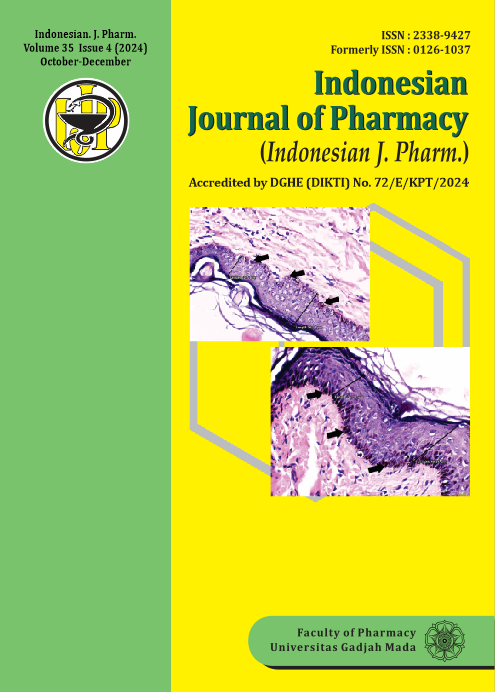Network Pharmacology and Molecular Mechanism of Traditional Indonesian Medicine in Hypertension Treatment
Abstract
Scientific herbal formulations are used clinically to treat hypertension, but their functional molecular mechanisms remain to be elucidated. This study was identified the molecular pathways by which scientific herbal remedies for treating hypertension work. The identified compounds were then excluded by measuring oral bioavailability and drug similarity. The network was created using Cytoscape version 3.8, and the predicted target information was obtained from a number of databases, including SwissTarget Prediction, STRING, Online Mendelian Inheritance in Man (OMIM), and Kyoto Encyclopedia of Genes and Genomes (KEGG). The decoction’s method for lowering hypertension was then clarified using an enrichment analysis. It was discovered that bioavailability and drug similarity metrics existed for a total of 44 identified substances. The results of pathway analysis using KEGG revealed that the potential targets were correlated antihypertensive mechanism of herbal medicine such as the HIF-1 signaling pathway, Relaxin signaling pathway, PI3K signaling pathway, and MAPK signaling pathway. Scientific herbal formulas' pressure-lowering mechanisms include those related to vascular endothelium and atherosclerosis, which involve several signaling pathways such as the HIF-1 signaling pathway, the Relaxin signaling pathway, the PI3K signaling pathway, and the MAPK signaling pathway.
References
Bunaim, M.K., Kamisah, Y., Mohd Mustazil, M.N., Fadhlullah Zuhair, J.S., Juliana, A.H., Muhammad, N.(2021). Centella asiatica (L.) Urb. Prevents Hypertension and Protects the Heart in Chronic Nitric Oxide Deficiency Rat Model. Front Pharmacol. 12, 742562. Published 2021 Dec 3. doi:10.3389/fphar.2021.742562.
Campos, M.G., Oropeza, M.V., Villanueva, T., Aguilar, M.I., Delgado, G., Ponce, H.A. (2000). Xanthorrhizol induces endothelium-independent relaxation of rat thoracic aorta. Life Sci. 67(3), 327-333. doi:10.1016/s0024-3205(00)00619-6.
Daina, A., Michielin, O., Zoete, V. (2017). SwissADME: a free web tool to evaluate pharmacokinetics, drug-likeness and medicinal chemistry friendliness of small molecules. Sci Rep. 7, 42717. Published 2017 Mar 3. doi:10.1038/srep42717.
Doncheva, N.T., Morris, J.H., Gorodkin, J., Jensen, L.J. (2019). Cytoscape StringApp: Network Analysis and Visualization of Proteomics Data. J Proteome Res. 18(2), 623-632. doi:10.1021/acs.jproteome.8b00702.
Duarte, J., Pérez-Palencia, R., Vargas, F., et al. (2001). Antihypertensive effects of the flavonoid quercetin in spontaneously hypertensive rats. Br J Pharmacol. 133(1), 117-124. doi:10.1038/sj.bjp.0704064.
Elfahmi, Woerdenbag, H.J., Kayser, O. (2014). Jamu: Indonesian Traditional Herbal Medicine towards Rational Phytopharmacological Use. J. Herb. Med. 4(2), 51–73. Doi: 10.1016/j.hermed.2014.01.002.
Gfeller, D., Grosdidier, A., Wirth, M., Daina, A., Michielin, O., Zoete, V. (2014). SwissTargetPrediction: a web server for target prediction of bioactive small molecules. Nucleic Acids Res. 42(Web Server issue):W32-W38. doi:10.1093/nar/gku293.
Jia-Ming, W., Jun-Ping, Z., Tong-Yu, Z., Yu-Ying, L., Lin, K., Zhi-Hua, G., Ya, L. (2019). Application of Network Pharmacology to Explore the Mechanism of Yi Xin Tai Formula in Treating Heart Failure. Digit. Chin. Med. 2(4), 237–256. https://doi.org/10.1016/j.dcmed.2020.01.005.
Larson, A.J., Symons, J.D., Jalili, T. (2010). Quercetin: A Treatment for Hypertension?-A Review of Efficacy and Mechanisms. Pharmaceuticals (Basel). 3(1), 237-250. Published 2010 Jan 19. doi:10.3390/ph3010237.
Lee, M.Y., Luciano, A.K., Ackah, E., et al. (2011). Endothelial Akt1 mediates angiogenesis by phosphorylating multiple angiogenic substrates. Proc Natl Acad Sci U S A. 11(35), 12865-12870. doi:10.1073/pnas.1408472111.
Maneesai, P., Bunbupha, S., Kukongviriyapan, U., et al. (2017). Effect of asiatic acid on the Ang II-AT1R-NADPH oxidase-NF-κB pathway in renovascular hypertensive rats. Naunyn Schmiedebergs Arch Pharmacol. 390(10), 1073-1083. doi:10.1007/s00210-017-1408-x.
Mohebbati, R., Kamkar-del, Y., Kazemi, F., Rakhshandeh, H., Naser, M. (2020). Hypotensive Effect of Centella Asiatica L. Extract in Acute Angiotensin II-Induced Hypertension. Iranian Journal of Pharmaceutical Sciences, 16(4), 71-80. doi: 10.22034/ijps.2020.121635.1642.
Paulin, R., Meloche, J., Bonnet, S. (2012). STAT3 signaling in pulmonary arterial hypertension. JAKSTAT. 1(4), 223-233. doi:10.4161/jkst.22366.
Raman, K. (2010). Construction and analysis of protein-protein interaction networks. Autom Exp. 2(1), 2. Published 2010 Feb 15. doi:10.1186/1759-4499-2-2.
Riskesdas. (2010). Riset Kesehatan Dasar. Badan Penelitian Dan Pengembangan Kesehatan Kementerian Kesehatan RI Tahun 2010. Lap. Nas. 2010, 1–446.
Riskesdas. (2013). Hasil Riset Kesehatan Dasar 2013. Badan Penelitian Dan Pengembangan Kesehatan Kementerian Kesehatan RI Tahun 2013.
Sawada, R., Iwata, M., Umezaki, M., et al. (2018). KampoDB, database of predicted targets and functional annotations of natural medicines. Sci Rep. 8(1), 11216. doi:10.1038/s41598-018-29516-1.
Shannon, P., Markiel, A., Ozier, O., et al. (2003). Cytoscape: a software environment for integrated models of biomolecular interaction networks. Genome Res. 13(11), 2498-2504. doi:10.1101/gr.1239303.
Szklarczyk, D., Gable, A.L., Lyon, D., et al. (2019). STRING v11: protein-protein association networks with increased coverage, supporting functional discovery in genome-wide experimental datasets. Nucleic Acids Res. 7(D1):D607-D613. doi:10.1093/nar/gky1131.
Tocci, G., Presta, V., Volpe, M. (2020). Hypertensive crisis management in the emergency room: time to change?. J Hypertens. 38(1), 33-34. doi:10.1097/HJH.0000000000002235.
Triyono, A., Zulkarnain, Z., Mana, T.A. (2018). Studi Klinis Ramuan Jamu Antihipertensi Pada Pasien Hipertensi Derajat I. J. Kefarmasian Indones. 8(1), 17–25.
WHO. (2021). Hypertension. Hypertension Prevalence. Retrieved from https://www.who.int/health-topics/hypertension/#tab=tab_1 (accessed 2021-02-15).
Zhang, Z., Yao, L., Yang, J., Wang, Z., Du, G. (2018). PI3K/Akt and HIF‑1 signaling pathway in hypoxia‑ischemia (Review). Mol Med Rep. 18(4), 3547-3554. doi:10.3892/mmr.2018.9375.








